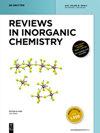Ligand isomerism in Pt(II) complexes – structural aspects
IF 3.1
3区 化学
Q1 CHEMISTRY, INORGANIC & NUCLEAR
引用次数: 2
Abstract
Abstract This review has focused on ligand isomers in Pt(II) complexes. There are a variety of inner coordination spheres about the platinum(II) atom (PtN4, PtN2Cl2, PtP2Cl2, PtPNC2, PtPNCl2, PtP2CBr, PtP2CS), build up by mono- and bidentate ligands. The bidentate ligands create a variety of metallocyclic rings. The L–Pt–L bite angle (mean values) open in the sequence: 73.1° (PNP) < 78.7° (NC2C) < 80.4° (NC2N) < 86.4° (PC2P) < 86.7° (PNNP) < 93.0° (CC3S). There are three types of isomers: ligand, mixed – (ligand + distortion), and mixed – (ligand + cis-trans), isomers, which are rarity.铂(II)配合物中的配体异构体-结构方面
摘要本文综述了Pt(II)配合物中的配体异构体。铂(II)原子周围有各种内部配位球(PtN4、PtN2Cl2、PtP2Cl2、PtPNC2、PtPNCl2、PtP2CBr、PtP2CS),由单齿和双齿配体构建。双齿配体形成各种金属环。L–Pt–L咬合角(平均值)按顺序打开:73.1°(PNP)<78.7°(NC2C)<80.4°(NC2N)<86.4°(PC2P)<867°(PNNP)<93.0°(CC3S)。异构体有三种类型:配体、混合-(配体+畸变)和混合-(配位体+顺反式)异构体,这是罕见的。
本文章由计算机程序翻译,如有差异,请以英文原文为准。
求助全文
约1分钟内获得全文
求助全文
来源期刊

Reviews in Inorganic Chemistry
化学-分析化学
CiteScore
7.30
自引率
4.90%
发文量
20
审稿时长
1 months
期刊介绍:
Reviews in Inorganic Chemistry (REVIC) is a quarterly, peer-reviewed journal that focuses on developments in inorganic chemistry. Technical reviews offer detailed synthesis protocols, reviews of methodology and descriptions of apparatus. Topics are treated from a synthetic, theoretical, or analytical perspective. The editors and the publisher are committed to high quality standards and rapid handling of the review and publication process. The journal publishes all aspects of solid-state, molecular and surface chemistry. Topics may be treated from a synthetic, theoretical, or analytical perspective. The editors and the publisher are commited to high quality standards and rapid handling of the review and publication process.
Topics:
-Main group chemistry-
Transition metal chemistry-
Coordination chemistry-
Organometallic chemistry-
Catalysis-
Bioinorganic chemistry-
Supramolecular chemistry-
Ionic liquids
 求助内容:
求助内容: 应助结果提醒方式:
应助结果提醒方式:


